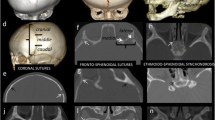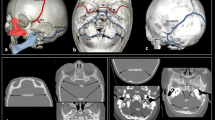Abstract
Purpose
Craniosynostostic syndromes are due to multisuture synostoses and affect the entire craniofacial skeleton. This study analyzed the facial complex and airways to quantify the relationship between insufficient facial growth, airways obstruction, and the sutural pattern of the splanchnocranium and cranial fossae.
Methods
Preoperative high-resolution CT images in 19 infants with syndromic craniosynostosis were quantitatively analyzed. Because all children showed involvement of minor sutures/synchondroses coursing in the posterior cranial fossa, they were divided into three groups according to the synostotic involvement of “minor” sutures/synchondroses coursing in anterior (ACF) and middle (MCF) cranial fossae: group 1 (ACF), group 2 (MCF), and group 3 (ACF-MCF). Analysis of the facial complex and airway was performed. Each group was compared with age-matched healthy subjects.
Results
Premature closure of skull base synchondroses of ACF and MCF was found only in groups MCF and ACF-MCF. Group MCF showed synostosis in the posterior branch of the coronal ring and reduced anterior hemifossae lengths while group ACF-MCF showed synostosis in the anterior branch of the coronal ring and reduced middle hemifossae lengths. No group showed reduced maxillary or mandibular volumes but group MCF showed synostosis of the zygomaticomaxillary sutures and maxillary retrusion. All groups showed reduced airway volume but group 2 had a higher degree of airway hypoplasia.
Conclusion
The skull base synostotic process drives the changes in facial complex growth and airway obstruction. Premature closure of synchondroses/sutures in the posterior branch of the coronal ring causes insufficient facial growth, maxillary retrusion, and more severe airway reduction.





Similar content being viewed by others
References
Shetye PR, Davidson EH, Sorkin M, Grayson BH, McCarthy JG (2010) Evaluation of three surgical techniques for advancement of the midface in growing children with syndromic craniosynostosis. Plast Reconstr Surg 126(3):982–994. https://doi.org/10.1097/PRS.0b013e3181e6051e00006534-201009000-00031
Saltaji H, Altalibi M, Major MP, Al-Nuaimi MH, Tabbaa S, Major PW, Flores-Mir C (2014) Le Fort III distraction osteogenesis versus conventional Le Fort III osteotomy in correction of syndromic midfacial hypoplasia: a systematic review. J Oral Maxillofac Surg 72(5):959–972. https://doi.org/10.1016/j.joms.2013.09.039
Anantheswar YN, Venkataramana NK (2009) Pediatric craniofacial surgery for craniosynostosis: our experience and current concepts: parts—2. J Pediatr Neurosci 4(2):100–107. https://doi.org/10.4103/1817-1745.57328JPN-4-100
Derderian C, Seaward J (2012) Syndromic craniosynostosis. Semin Plast Surg 26(2):64–75. https://doi.org/10.1055/s-0032-132006426064
Tahiri Y, Paliga JT, Vossough A, Bartlett SP, Taylor JA (2014) The spheno-occipital synchondrosis fuses prematurely in patients with Crouzon syndrome and midface hypoplasia compared with age- and gender-matched controls. J Oral Maxillofac Surg 72(6):1173–1179. https://doi.org/10.1016/j.joms.2013.11.015
Calandrelli R, D’Apolito G, Gaudino S, Sciandra MC, Caldarelli M, Colosimo C (2014) Identification of skull base sutures and craniofacial anomalies in children with craniosynostosis: utility of multidetector CT. Radiol Med 119(9):694–704. https://doi.org/10.1007/s11547-014-0387-y
Calandrelli R, D’Apolito G, Gaudino S, Stefanetti M, Massimi L, Di Rocco C, Colosimo C (2014) Radiological assessment of skull base changes in children with syndromic craniosynostosis: role of “minor” sutures. Neuroradiology 56(10):865–875. https://doi.org/10.1007/s00234-014-1392-5
Weissheimer A, Menezes LM, Sameshima GT, Enciso R, Pham J, Grauer D (2012) Imaging software accuracy for 3-dimensional analysis of the upper airway. Am J Orthod Dentofacial Orthop 142(6):801–813. https://doi.org/10.1016/j.ajodo.2012.07.015
Faul F, Erdfelder E, Lang AG, Buchner A (2007) G*Power 3: a flexible statistical power analysis program for the social, behavioral, and biomedical sciences. Behav Res Methods 39(2):175–191
Ko EW, Chen PK, Tai IC, Huang CS (2012) Fronto-facial monobloc distraction in syndromic craniosynostosis. Three-dimensional evaluation of treatment outcome and facial growth. Int J Oral Maxillofac Surg 41(1):20–27. https://doi.org/10.1016/j.ijom.2011.09.012
Nout E, Bannink N, Koudstaal MJ, Veenland JF, Joosten KF, Poublon RM, van der Wal KG, Mathijssen IM, Wolvius EB (2012) Upper airway changes in syndromic craniosynostosis patients following midface or monobloc advancement: correlation between volume changes and respiratory outcome. J Craniomaxillofac Surg 40(3):209–214. https://doi.org/10.1016/j.jcms.2011.04.017
Sculerati N, Gottlieb MD, Zimbler MS, Chibbaro PD, McCarthy JG (1998) Airway management in children with major craniofacial anomalies. Laryngoscope 108(12):1806–1812
Bannink N, Nout E, Wolvius EB, Hoeve HL, Joosten KF, Mathijssen IM (2010) Obstructive sleep apnea in children with syndromic craniosynostosis: long-term respiratory outcome of midface advancement. Int J Oral Maxillofac Surg 39(2):115–121. https://doi.org/10.1016/j.ijom.2009.11.021
Paliga JT, Goldstein JA, Vossough A, Bartlett SP, Taylor JA (2014) Premature closure of the spheno-occipital synchondrosis in Pfeiffer syndrome: a link to midface hypoplasia. J Craniofac Surg 25(1):202–205. https://doi.org/10.1097/SCS.0000000000000386
Boutros S, Shetye PR, Ghali S, Carter CR, McCarthy JG, Grayson BH (2007) Morphology and growth of the mandible in Crouzon, Apert, and Pfeiffer syndromes. J Craniofac Surg 18(1):146–150. https://doi.org/10.1097/01.scs.0000248655.53405.a7
Forte AJ, Alonso N, Persing JA, Pfaff MJ, Brooks ED, Steinbacher DM (2014) Analysis of midface retrusion in Crouzon and Apert syndromes. Plast Reconstr Surg 134(2):285–293. https://doi.org/10.1097/PRS.000000000000036000006534-201408000-00026
Carinci F, Avantaggiato A, Curioni C (1994) Crouzon syndrome: cephalometric analysis and evaluation of pathogenesis. Cleft Palate Craniofac J 31(3):201–209. https://doi.org/10.1597/1545-1569(1994)031<0201:CSCAAE>2.3.CO;2
Grayson BH, Weintraub N, Bookstein FL, McCarthy JG (1985) A comparative cephalometric study of the cranial base in craniofacial anomalies: part I: tensor analysis. Cleft Palate J 22(2):75–87
Langford RJ, Sgouros S, Natarajan K, Nishikawa H, Dover MS, Hockley AD (2003) Maxillary volume growth in childhood. Plast Reconstr Surg 111(5):1591–1597. https://doi.org/10.1097/01.PRS.0000057971.87632.37
Roche J, Frawley G, Heggie A (2002) Difficult tracheal intubation induced by maxillary distraction devices in craniosynostosis syndromes. Paediatr Anaesth 12(3):227–234
Purushothaman R, Cox TC, Maga AM, Cunningham ML (2011) Facial suture synostosis of newborn Fgfr1(P250R/+) and Fgfr2(S252W/+) mouse models of Pfeiffer and Apert syndromes. Birth Defects Res A Clin Mol Teratol 91(7):603–609. https://doi.org/10.1002/bdra.20811
Tamburrini G, Caldarelli M, Massimi L, Gasparini G, Pelo S, Di Rocco C (2012) Complex craniosynostoses: a review of the prominent clinical features and the related management strategies. Childs Nerv Syst 28(9):1511–1523. https://doi.org/10.1007/s00381-012-1819-4
Wery MF, Nada RM, van der Meulen JJ, Wolvius EB, Ongkosuwito EM (2015) Three-dimensional computed tomographic evaluation of Le Fort III distraction osteogenesis with an external device in syndromic craniosynostosis. Br J Oral Maxillofac Surg 53(3):285–291. https://doi.org/10.1016/j.bjoms.2014.12.016
Author information
Authors and Affiliations
Corresponding author
Ethics declarations
Funding
No funding was received for this study.
Conflict of interest statement
CC consults for Bracco Diagnostics Inc. and Bayer HealthCare.
Ethical approval
We declare that all procedures performed in studies involving human participants were in accordance with the ethical standards of the institutional and/or national research committee and with the 1964 Helsinki declaration and its later amendments or comparable ethical standards. For this type of study formal consent is not required.
Informed consent
Informed consent was obtained from all individual participants included in the study.
Rights and permissions
About this article
Cite this article
Calandrelli, R., Pilato, F., Massimi, L. et al. Quantitative evaluation of facial hypoplasia and airway obstruction in infants with syndromic craniosynostosis: relationship with skull base and splanchnocranium sutural pattern. Neuroradiology 60, 517–528 (2018). https://doi.org/10.1007/s00234-018-2005-5
Received:
Accepted:
Published:
Issue Date:
DOI: https://doi.org/10.1007/s00234-018-2005-5




